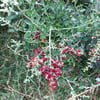Rhagodia candolleana - Sea-Berry Saltbush
Sea-Berry Saltbush (Rhagodia candolleana) is a remarkable native Australian plant that thrives in coastal and arid environments. Its unique habit and tolerance to various conditions make it an excellent addition to gardens situated in coastal regions.
Place in Local Habitat and Ecosystem Distribution:
Sea-Berry Saltbush plays a significant role in coastal and arid ecosystems. Its presence helps stabilize sandy soils, prevent erosion, and provide a habitat for various coastal organisms.
Planting Companions:
For an authentic coastal or arid-themed garden, consider planting Sea-Berry Saltbush alongside other salt-tolerant species such as Myoporum insulare, Carpobrotus rossii, and Leptospermum laevigatum. These companion plants complement Sea-Berry Saltbush's adaptability to challenging conditions.
Human and Wildlife Uses:
Traditionally, Indigenous Australian communities valued Sea-Berry Saltbush for its edible berries, which were used as a source of sustenance and the paint the body. Its leaves were also eaten. In modern landscapes, the plant offers shelter to small animals and birds while enhancing the ecological diversity of coastal and arid areas.
Care Instructions:
Introducing Sea-Berry Saltbush to your garden requires selecting a sunny spot with well-draining soil. This hardy plant can tolerate both coastal and arid conditions, making it an easy-to-maintain choice. Regular watering during establishment is essential, but once established, Sea-Berry Saltbush can thrive with minimal care. It is one of the few plants that can thrive in heavily alkalized soil at the base of pines and cypress pines.
Size, Height, Width, Flower, and Leaf Characteristics:
Sea-Berry Saltbush typically grows to a height of 1 to 1.5 meters, forming a dense, rounded shrub. Moreover, it can be trained to adopt a vine-like growth habit. Its leaves are a glossy green color, offering a lovely contrast to other silvery coastal plants. Inconspicuous flowers appear during the flowering season, contributing to the plant's overall aesthetic.
Latin Etymology:
The genus name "Rhagodia" originates from the Greek word "rhagos," meaning a cluster, referring to the clustered arrangement of the flowers. The species name "candolleana" is an homage to the French botanist Augustin Pyramus de Candolle.
Bringing Sea-Berry Saltbush Home:
To incorporate Sea-Berry Saltbush into your garden, choose a suitable location with well-draining soil and ample sunlight. Its adaptability to coastal and arid conditions makes it a versatile choice, adding a touch of natural beauty and resilience to your landscape. With its historical significance and ecological benefits, Sea-Berry Saltbush serves as a testament to the enduring relationship between Australia's native plants and its Indigenous cultures.

